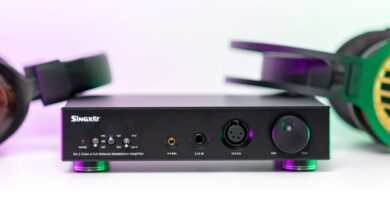SMSL SP400 Review – A Flawed Masterpiece
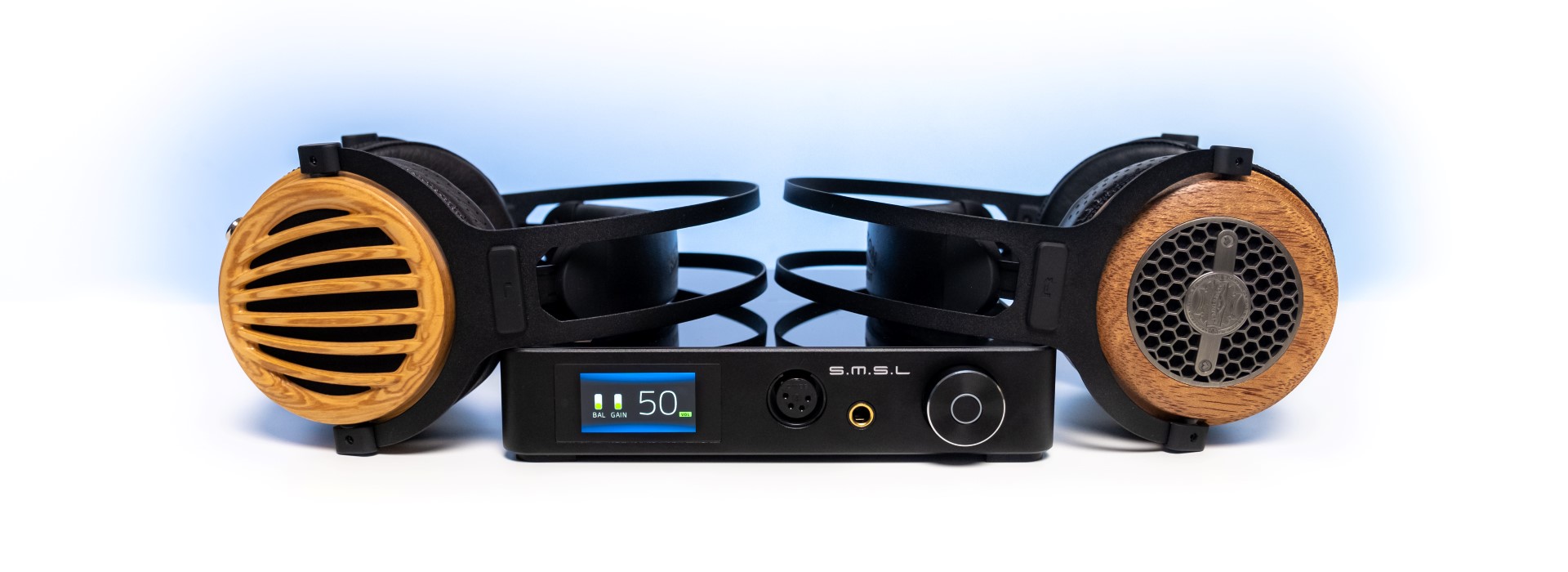
My Video Review:
With the introduction of SP200, SMSL embraced the THX-AAA hype train that everybody was talking around the block. Finally, there was a serious contender in town for the overrated Drop THX-789 and as my comprehensive comparison of the THX-es proved, in some ways it even outclassed it. SMSL plunged high and established itself as part of the good-fellas, offering plenty of power even for hungry planar-magnetics, some very low-distortion numbers and a lack of a sound signature, making it a true wire-with-gain amplifier at less than $300! Suddenly, high-end sonics could be achieved at a price of a custom-made headphone cable, forcing Drop to lower the price of THX-789 from $399 to $299 so they would compete again. Instead of resting on Laurus Nobilis leaves and catch some breath, SMSL went totally berserk by announcing in April 2020 that two higher performing headphone amplifiers are in the works. That was the most discussed Tweet SMSL ever posted, as people were genuinely interested in learning more about them. In August 2020, SMSL revealed the first pictures and the actual names of their upcoming SH-9 and SP400 amplifiers and people started asking even more questions. As my SH-9 review confirmed, it felt like a polished version of SP200 from any point of view. On one hand it had pretty much the same power ratings, but on the other its background noise was nowhere to be found even with ultra-sensitive IEMs, its volume control worked much better at low listening volumes, it measured and sounded substantially better and it looked like a mini version of my Benchmark HPA4 thanks to its colorful LCD screen and simple to use UI. The best part? It was offered at the same original price that SP200 had one year prior.
With SP400, SMSL is targeting the top of the crop, releasing a statement device that could drive pretty much any headphone on the market. It’s a world first amp on several key aspects too, for example it’s the first THX amplifier that can pump 12 Watts into your precious headphones, it’s the first one using four flagship AAA-888 modules instead of two found on Benchmark HPA4, on SMSL SP200 and on SH-9, meaning that it’s the first true-balanced input to output AAA-888 amplifier there is. So, could it be true? A true high-end piece of kit with a mid-fi price tag attached to it? Let’s find out together!
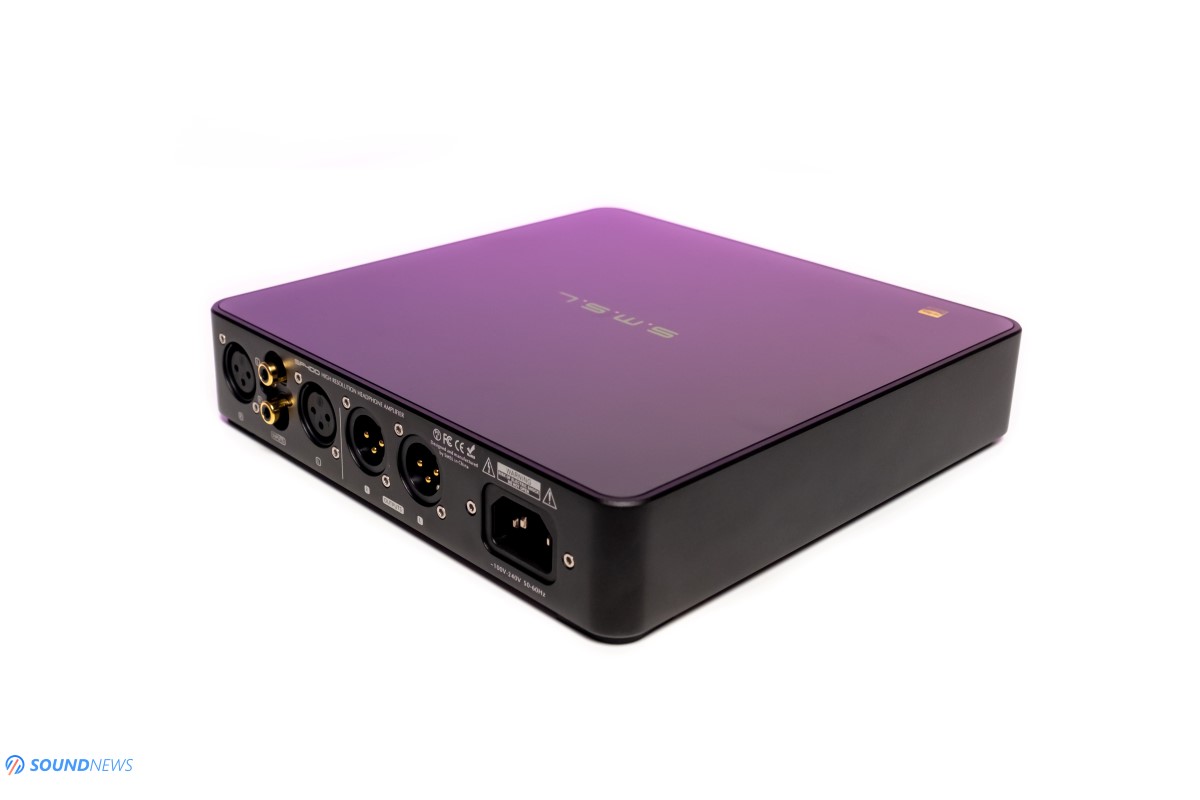
Unboxing Experience
Compared to all other boxes we’ve received so far from SMSL, this one felt like the mothership of them all as it was considerably bigger and heavier. SMSL used a thicker card-board with lots of foam for protection. It is a double boxed affair, as it normally should, inside the product box you’ll find the unit itself, a power cord, a fancy user-manual and a remote control – which is something I don’t see very often with headphone amplifiers, but since SP400 can be used as a preamp in a loudspeaker setup, it makes a lot of sense and I wish Topping A90 had one too.
This is the same remote I’ve seen on SU-9 DAC and SH-9 headphone amplifier, it is their standard matte-black one with rubberized buttons, press the B button first to start controlling the SP400.

Design & Build Quality
Build quality wise, this is the nicest SMSL unit I’ve tested so far. It has a very good weight to it, it feels balanced in hand, it has pretty much the same square surface as my Benchmark HPA4 – maybe it was intentional as it can be considered a direct competitor to it at a much lower price point. It has a 1.9” LCD screen and an easy-to-use UI that again reminds me about the HPA4, it is very convenient to use as you can immediately see the volume position, the selected gain and input source, believe it or not, it’s a big quality of life improvement. Without three analog switches that were present on SP200, the newest device looks much sleeker without them, it is more elegant and since it will memorize the selected gain and volume position, I will not miss them.
It screams high-quality, as everywhere I’m looking, I see a higher attention to the smallest details. It looks like a matte-black metal brick, it is milled on a CNC machine with just two panels attached on top and under the unit. It has the same body thickness of about 3.5mm with SU-9 and SH-9, so wireless interference shouldn’t be a problem. The front panel houses a glass sheet with an LCD screen behind it. The volume knob is a big upgrade to the one found on the SP200 and it is the same found on SH-9. It doesn’t wobble at all; it is a stepped volume knob with exactly 99 steps. The best part of it? It’s using a ladder of high-performance analog relays to control its volume. Yes, that is a high-end relay controlled stepped volume attenuator, exactly what I have in the Benchmark HPA4 and exactly what Flux Labs Acoustics put in their FA-10 and FA-12 amplifiers. There are four rubber feet beneath it taking the shape of the unit, those are bigger and deeper compared to the ones on SU-9 and SH-9, it will not lean to any side as it happens with those devices. I find the build quality really nice, but I still have one complaint that bothers the hell out of me. Its top plate is covered with tempered glass and while it gives a very positive first impression, immediately after touching it, it becomes obvious that it wasn’t their brightest idea. It’s a fricking fingerprint and dust particles magnet. I tend to put my headphones sometimes on the headphone amp itself, but I can’t do it with SP400 fearing of scratching that glass or even worse, breaking it. Another issue is of course managing your headphones around it, you should be extra careful with them around. This is its biggest downside, it was a less inspired design decision, a simple matte-black metal top would look the same, but will resist a lot more use and abuse.
As usual, SMSL moved most of its screws on the back and under the unit, so it would look much cleaner. Everything else looks really nice, everything is secured tightly, nothing is wobbling around, it looks clean and minimalist, with a very high WAF factor attached to it. SMSL is offering it only in black and at 1330 grams or almost ~3 pounds, it feels like a compact headphone amplifier, with a huge power reserve under its hood.

Controls & I/O
SP400 has a clean looking front panel, with just an LCD screen on the left and a volume knob on the right that also works as a menu navigator. Its LCD screen is not that big, but thanks to its bigger lettering, you can clearly see the volume level, the selected input and the gain position. It has two headphone jacks: a regular 6.35 mm (1/4”) and a 4-pin XLR balanced output.
On the back you can see two analog inputs, a balanced XLR and a single ended RCA one, there’s also a balanced XLR output just in case you’ll want to use it as a preamp and on the right you can spot a universal 100 V to 240 V AC inlet.
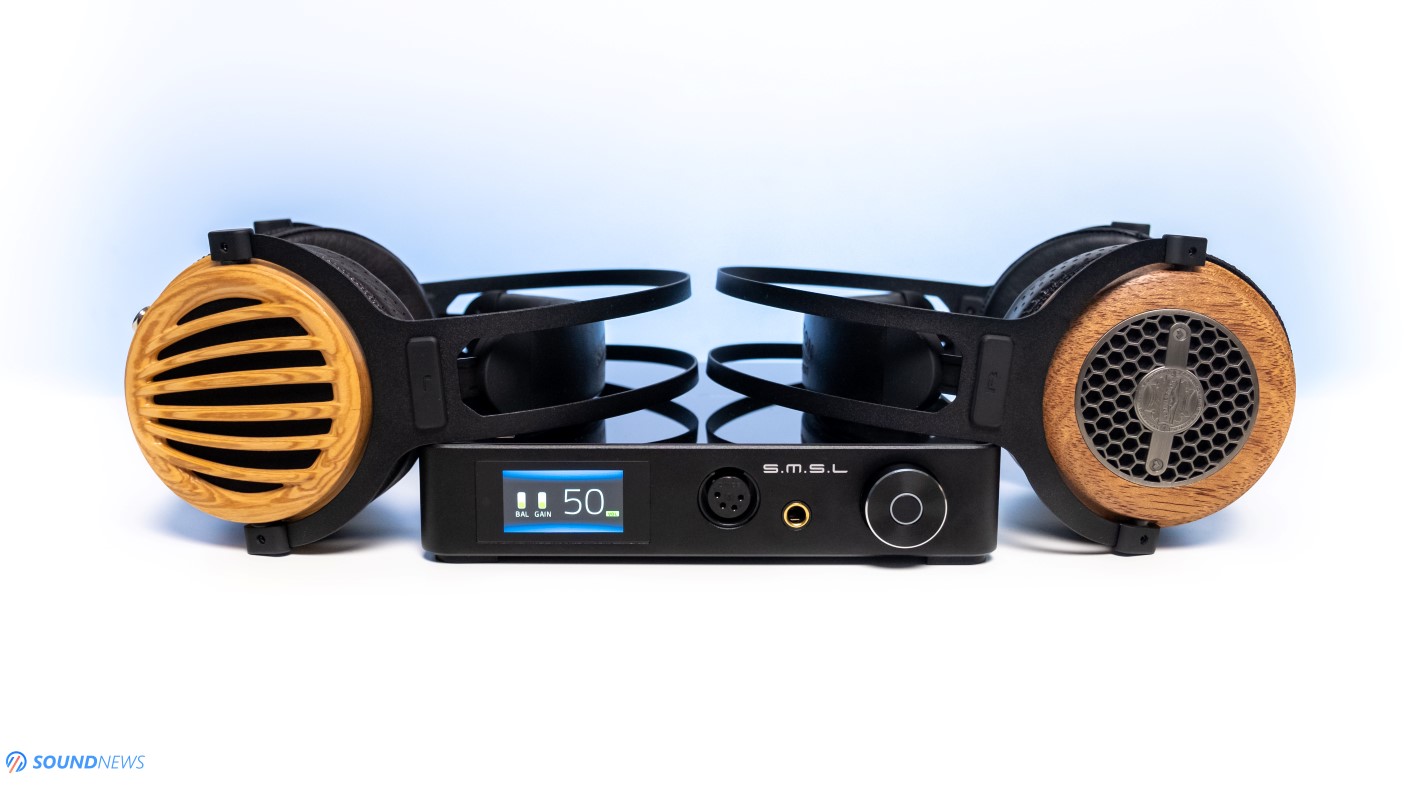
Menu Options
Absolutely all its features can be controlled via its remote or volume knob that doubles as a joystick for its menu. In the stand-by mode a single press on the knob will power it on and another press will enter its menu where you can select:
- Input – Balanced (XLR) or Unbalanced (RCA) – very straightforward
- Gain: Low (best setting for IEMs or sensitive headphones), Mid or High (for your power-hungry headphones)
- Volume Mode: Enable or Disable. When its enabled, it will reduce the frequency of relay operation, thus increasing the service life of those relays. If you disable this feature, you will hear clicks on every step.
- Brightness – 6 positions, lowest one is almost dimming it completely
- Version – will show your Hardware and Software version (for now it is at version 1.0)
This is basically it, a very simple and straightforward graphical user interface. Most of these settings are set and forget, with the exception of the Gain setting which will be used more often. HPA4 can sleep tightly now, as Benchmark implemented a lot more features, which I did mention in its dedicated review.
Under the hood of SP400
Up to this point, SP400 is the fourth THX-AAA-888 based headphone amplifier on the market, but it is the first one having four modules instead on two. In simple terms, this is the first quad-mono AAA-888 amplifier available and the first true balanced input to output amplifier, so I should definitely hear an improvement over the SH-9 and who knows, maybe over the HPA4 as well. If you lived in a man cave for the last three years or so or never heard about them, THX AAA modules are reducing harmonic, intermodulation and crossover distortion by 20 to 40 dB by offering a true to life, realistic and fatigue-free listening experience. It accomplishes that by using a patented feed-forward topology to null conventional distortion and noise levels, resulting in the world’s most linear amplifiers. THX AAA allows the amplifier to reach its maximum power without any kind of distortion that would normally appear in traditional amplifiers.

The funny part is that on the inside, the analog section of SP400 is looking exactly like a double version of SMSL SH-9, here is a picture of them side by side that will tell you more. You can clearly see double power supplies, its power filtering doubled, you can spot four THX modules instead of two, the number of analog relays remained the same: 9 relays for the headphone amp section and 2 additional ones for its preamp section – that were missing on SH-9. Having a twice as big power supply and analog section, resulted in doubling its power output, from 6 Watts on SP200 and SH-9, SP400 is now offering a staggering number of 12 Watts per channel in 16 Ohms! That is a lot of power and it is currently the most powerful THX-equipped headphone amplifier on the market.
It has an output impedance close to zero so that damping factor wouldn’t be affected at all and at only 1.9 micro volts of noise, it should pair nicely even with ultra-sensitive IEMs. Most THX AAA amplifiers have their noise floor undetected at any volume level, but will see how SP400 performs with ultra-sensitive loads very soon.
All that power will mean nothing if there isn’t a wide bandwidth to deliver all that instantly to your precious headphones. The bandwidth of SP400 extends from 0.1 Hz to over 500 kHz! Meaning that SP400 will deliver an instant amplitude and should have a perfect phase accuracy over the entire audio bandwidth.
A very low noise amplifier will need a high-quality volume pot to preserve all the dynamic range and all the bits of the digital source, that is precisely why SMSL put the same ladder of analog relays that are sitting in their SH-9. All that was possible by using 9 relays for the headphone amp section and another 2 for its preamp section. My Benchmark HPA4 is also using a relay-controlled volume pot, but instead of 9 relays that are found on SP400, Benchmark has 24 of them to offer a state-of-the-art precision. Nonetheless, a relay-controlled volume pot is already high-end in my book and considering that SP400 goes for $629, I don’t have much to complain about.
SMSL used 2 x 24 Watt ultra-low-noise power supplies, those are encapsulated inside a metal shell and as with all THX AAA designs, the electrolytic caps are not sitting in the signal path, but are used for power filtering and storing for the purest possible signal path.
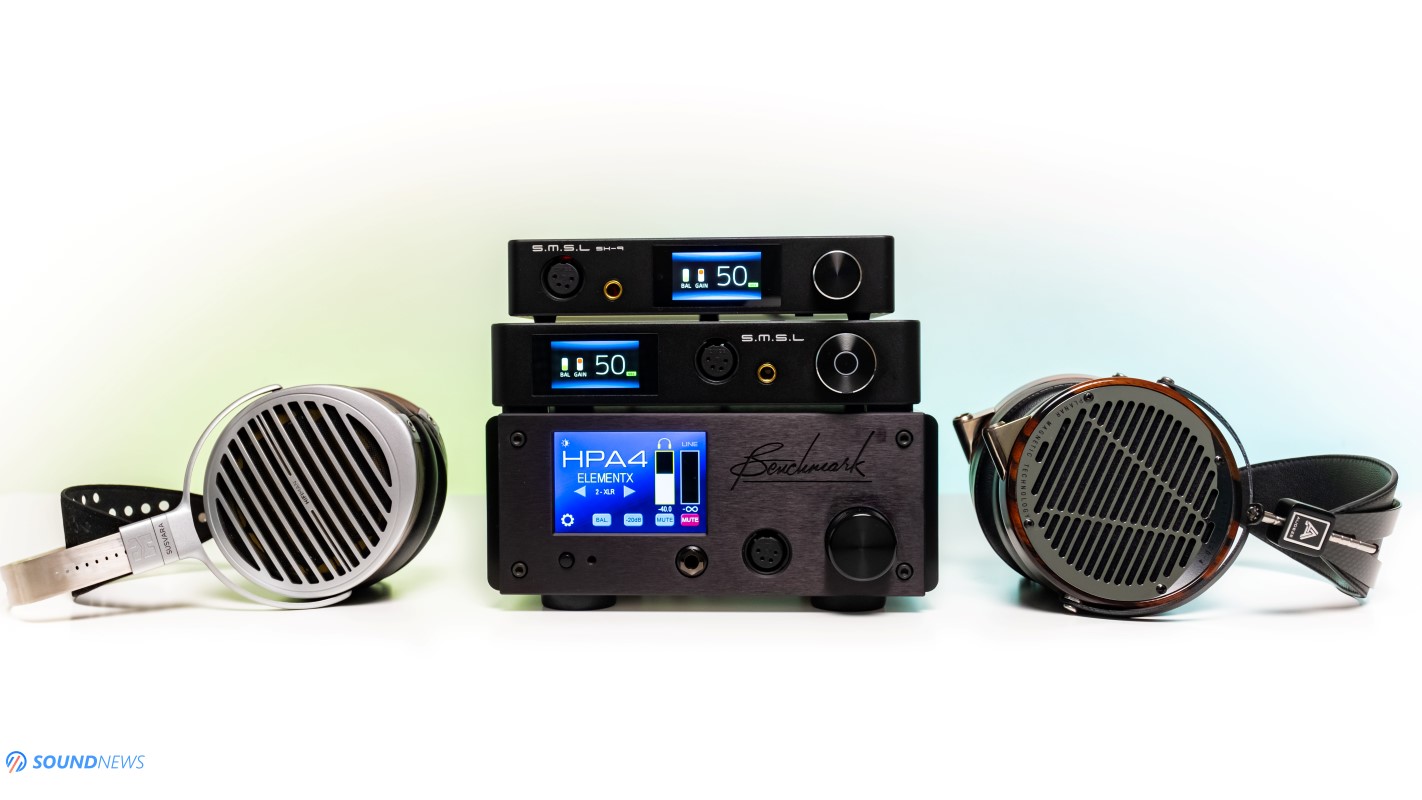
Test Equipment
SMSL SP400 was used in three different setups. At first it was connected to a reference Audiobyte HydraVox DAC that would help me checking its flow and soundstage as a headphone amplifier, then it was connected to a Matrix Audio Element X that helped with detail retrieval, transparency and speed / decay of the notes and after that it worked as a preamplifier, feeding a Keces S300 power amplifier that was driving a pair of KEF Reference 3. SMSL SP400 was used with ultra-sensitive IEMs, with regular multi-driver IEMs, with portable headphones, with desktop dynamic and planar-magnetic headphones. In the latest chapters it will be compared to its brother SH-9 and then to a Benchmark HPA4, be sure to read until the end for some entertaining comparisons. Okay everyone, time to hit some eardrums!
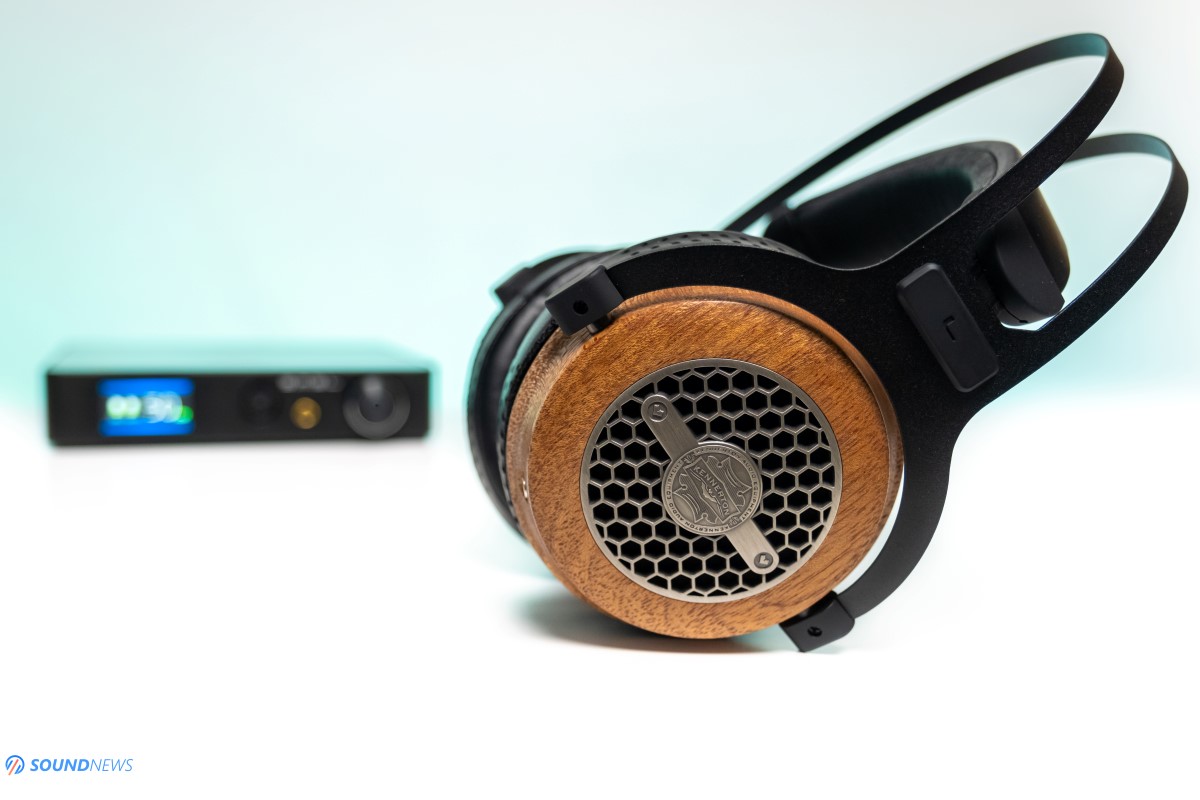
Sound Performance
I. Preliminary Impressions
Having heard so many THX Achromatic Audio Amplifiers by now, you would think that all of them should sound the same and this article would read like a copy paste as I would be describing the same sound for the fifth time, right? Truth is that all of them sounded so differently that I felt the urge to compare separately three THX amplifiers and write that down. THX released several modules and from the all, 888 modules sounded the best to me and I’m not about their uber low distortion and undetected noise levels, I’m about their sound signature. While they all disappear from your acoustic chain, leaving your headphones doing their work, 888-based amplifiers sounded by a hair bolder, they were wider and deeper sounding, and a lot more visceral and impactful to me. Those are having a higher current delivery, thus offering a better driver control with hardest to drive planar magnetics and that was the sole reason Benchmark HPA4 stood at my side no matter what for almost two years now. SP400 is reminding me a lot about the technicalities of the HPA4, but since it has a higher current delivery, it worked even better with the most demanding headphones like Hifiman Susvara. HPA4 and the rest of the THX mafia were in the clipping territory with Susvara, unable to sustain a deep bass note, it is painful saying this but SP400 is a better unit with headphones like Susvara, as it never entered its protection mode, it was never clipping and dynamics were always sky high.
While it is still not as precise as HPA4 is when it comes to ultimate transparency and detail retrieval, it still has double the power and that was immediately felt with headphones like Audeze LCD-4 and Hifiman Susvara. I knew that HPA4 was controlling well the drivers of some of the best headphones there is, but SP400 did that so gracefully and so easily, like it was nothing for it. HPA4 is no slouch and it is still one of the best I have ever heard, but with some particular headphones, SP400 worked better at less than ~4.75 times the price of HPA4, impressive! Isn’t it?
With an increase of power and current delivery, the windows toward music are widening considerably so the soundstage is improving on all axes, and from a cozy sounding SMSL SP200, to a much wider sounding SH-9, SP400 appears as the soundstage king especially via XLR input and output where the channel crosstalk is so much lower. I’m going as far as say that it feels extremely airy, so much so that it starts rivaling the sound of Flux Lab Acoustics FA-10 and to some degree feels bigger and airier compared to the excellent sounding Topping A90. The slight dry midrange and that emotionless sound of Drop THX-789 is nowhere to be found in here, as SP400 offered plenty of warmth with the right tunes, there was smoothness and I even had goose bumps all over my body for several times. There is one flaw that bothers me deeply, I will be mentioning in the third chapter so keep reading.

II. Noise Floor
Out of all headphone amplifiers that passed through these hands, only a handful of units offered a pitch-black background that worked exceptionally well with ultra-sensitive IEMs. The biggest majority of such amplifiers had either THX modules or NFCA modules developed by Topping, there were others too like the Sparkos Labs Aries and Aune S7 Pro that were extremely quiet and IEM friendly amplifiers. First attempts by SMSL as SH-8 and SP200 failed in delivering a noiseless performance across the board, as those were increasing the noise floor, lowering the overall performance with sensitive loads.
Starting with SH-9, SMSL invested a lot more time in R&D and the same can be said about the SP400. A well-designed power filtering, that ladder of resistors you normally see in high-end amplifiers paid-off big times by offering a perfect channel balance even at lowest listening levels and a pitch-black background. At my usual listening volume of around ~90 dB, no matter the selected gain, there was an absolute silence between passages with the most sensitive IEMs in my possession: the FiiO FA9. All other IEMs performed the same, as after pausing my music, there is only the sound of silence and nothing more. There is no point in trying portable or desktop ones, as those would perform absolutely the same. At its lowest volume position, the sound is not leaking as it happened on Topping A50S and there are plenty of volume steps until it reaches your desired position, so I’m happy to recommend it as an IEM friendly amplifier.
At a noise floor of just 1.9 microVolts at full power, very much in line with a Benchmark HPA4, I didn’t expect less and I’m glad to report that it works flawlessly with any headphone I tried it with, being it sensitive or not. Volume wise the highest I could go was 40 out of 99 on the low-gain position with IEMs, or about 35 on the high-gain on its single ended 6.35mm (1/4”) output. I would stick with low gain with sensitive IEMs and portable headphones, mid-gain with desktop dynamic headphones and use high-gain only with the most demanding ones.

III. Power Output
Being the most powerful THX-AAA amplifier has its perks as you can drive pretty much any headphone you want with flying colors. Yes, including the notorious Hifiman Susvara, add the Abyss 1266-TC in here too and the Audeze LCD-4 seems like a child’s play for it. As you can imagine, all those IEMs, portable dynamic headphones, desktop dynamic and planar magnetic headphones were driven to their fullest and there is nothing more to say about it. I felt an absolute control over the drivers, lightning-fast notes sounded exactly as they should, dynamics were pressing the gas pedal and SP400 was keeping up with all of that. Sincerely, everything except for the Susvara, sounded pretty much the same on the HPA4 by Benchmark, it was always fast and engaging, it was always visceral, it had a perfect pin point imagining and a well-spread and layered sound. With most headphones I didn’t even reach its half volume position on high-gain, even Hifiman Arya and Audeze LCD-4 felt like a feather weight load for it.
With all that said, there is one thing that I wish SMSL did differently, there is still hope as I’m having the Hardware and Software version 1.0 and maybe there is a chance, I can update it later on. The biggest issue that I’m writing about is its gain position. There is very little difference volume wise between low, to mid and then to high gain and while this doesn’t seem like a huge con, it is a huge con with hard to drive headphones like Hifiman Susvara. When you put it side by side with its smaller brother SH-9 that offers exactly half the power, it doesn’t sound more powerful at all and here are some examples.
While feeding a stronger signal of 84 dB into a 300 Hz sine wave into both amplifiers I am getting these results on high gain:
- Audeze LCD-4 will sit at 57 volume on SH-9 and that would equal a volume of 55 on SP400
- Hifiman Susvara will sit at 78 volume on SH-9 that would equal a volume of 76 on SP400
Considering that SP400 offers 12 Watts and SH-9 only 6 Watts, I expected a much bigger difference volume wise and the culprit seems to be the low gain amplifier design of both devices. From their user manuals, SP400 is having a max gain of 11.6 dB if its balanced inputs and outputs are being used and SH-9 has a max gain of 10 dB. If you are upgrading from SH-9 to SP400 and you don’t feel the increase of power, that is normal behavior, but you still should hear the improvements in terms of layering, easiness and dynamics, which are quite obvious from the start. Right now, it makes a lot of sense why that is happening, but I would still raise the high gain of SP400 to 20 dB so it would work much better with hardest loads as Hifiman Susvara, HE-6SE and Abyss 1266 TC.
With some very high dynamic range tracks, I’m at about 95 to 97 out of a maximum of 99 on the SP400, sometimes I’m maxed out and the only fault is its limited gain position. Susvara sounded good to great, definitely a little better than on the Benchmark HPA4, than on SH-9 and also compared to the Topping A90, but it still didn’t sound top notch as I have expected. There was little to no headroom left on tap so dynamics were a bit strained and limited, other than that, I have no complains when it comes to power.
SMSL, if you are reading this, if you are already planning on increasing the gain settings on SP400 and if that would happen soon, I would personally send you a thank you card and some home-made cookies. You know you want those.
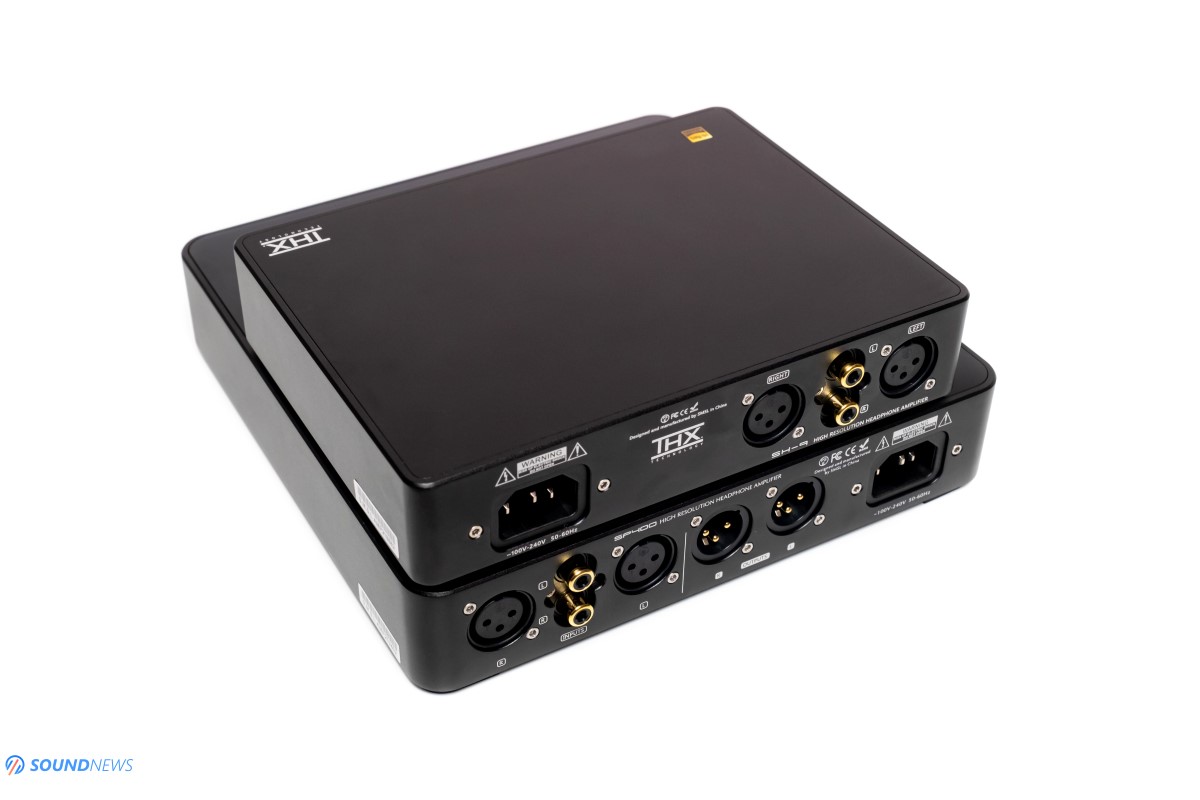
IV. Resolution & Transparency
This is a topic were all THX amplifiers excelled at and SP400 is really no different, with one big exception: it is even cleaner sounding than most of them, save for the HPA4 that still sits on an iron throne, reigning supreme. This is really the easier chapter to write about as there aren’t more transparent and more detailed headphone amplifiers than this. If you have any experience with THX or NFCA amplifiers, then this is basically the same.
With SP400 you’ll be listening to the source material first, then to the source itself and only then to your headphones. It doesn’t leave a stain on your music, it simply wants to disappear from your acoustic chain, without adding or drawing anything from there. I’ve a tried tens of headphone amplifiers by now and I still have the most respect for those that are not staying in the way of the acoustic signal. With an amplifier like this, doing DAC or headphone reviews becomes a whole lot easier, because I would be listening to the acoustic chain and not to the amplifier itself.
No matter the song that is playing, you know that you’ll be hearing the truth and only the truth and nothing else. If what you hear is not to your liking, blame the alcohol, blame your DAC or your headphone, even your music if you want, but not the amplifier itself, because it’s not there in your acoustic chain.
With a crazy signal-to-noise ratio of 133 dB, good luck finding any noise in your tunes, you will be listening to the limits of your DAC, headphones and of course of your hearing apparatus. Living with HPA4 for two years now, I’m not that easily impressed anymore with transparent sounding devices, SP400 is about on the same level, unearthing the smallest nuances and micro-details. Transparency goes hand in hand with detail retrieval, it was a child’s play focusing on any note I wanted, be it in front of me or somewhere to my right or left. SP400 is a hell of a transparent amplifier, it will let you be the conductor in your tunes, you can choose on what you want to focus and what’s less important. If you want to focus on the big picture, be my guest, lean back and relax, music will soon do its thing.
I can go on and on about how transparent and detailed SP400 can be as there is no other way to describe the sound of it. It always offered the last drop of micro-details, if there are movements in the auditorium and that somehow made its way into the recording, you’ll be surely hearing that easily. There are several pros and a con to all of this, anything can’t hide with an amplifier like this, on the flip side some older tunes with lots of background noises, pops and crackles could be too much and too distracting at times.

V. Transient Response
SP400 is a very speedy mustang and always challenges the headphone and the source that is connected to it. It goes wild and it goes fast, it kicks and it kicks hard, over and over again with high dynamic range tracks. Expect a lightning-fast start and stop of the drivers with electronica and modern music. Forget about spectral decay, its instantaneous and that creates the perception that nothing is standing between the source and your headphone. It’s a wire-with-gain amplifier alright and nothing will be stopping it, only if the music is demanding it. With a super-wide bandwidth of 0.1 Hz to 500 kHz it would be weird experiencing a less speedy sound. It is more or less on the same level with HPA4 by Benchmark and Topping A90, which mind you are still one of the fastest headphone amplifiers I’ve ever tried.
Lower tiered THX and NFCA amplifiers were always impressive in terms of speed, but not so much in terms of slam and ultimate impact, their power output was limited, hence moving less air in the lowest octaves, but SP400 is a completely difference beast. With a 48-Watt power supply, having 12-Watts on tap, bass notes were moving more air and all that created a higher sound pressure level. In simple words, a higher power output always leads to a much better slam and impact into the eardrums. This is exactly where SP400 felt bossy, powerful and really impressive. I’m still using a 16-Watt Flux Lab Acoustics FA-10 on a daily basis when I want to rock out hard with some planar magnetic headphones. SP400 almost matches the engagement factor of FA-10 and that is amazing to hear and experience first-hand. Finally, a THX amplifier that carries more warmth, more body, that sounds fast, but also visceral and engaging. So far, SP400 came up as the most fun and engaging THX amplifier and if you don’t want to deal with heat dissipation of class-A amplifiers, SP400 seems like an excellent middle-ground offering the same fun factor, without trading other technicalities like FA-10 is doing.
SP400 has a close to zero impedance, meaning that its higher power would be delivered instantly to your headphones, its damping factor is fully preserved with low and high impedance headphones and nothing would be stopping those drivers from achieving their maximum potential.

VI. Soundstage & Depth
The Achille’s Heel of all THX amplifiers has always been the soundstage size and while it was never bad or anything like that, only very few of them were great in here. For example, SMSL SP200 and Drop THX-789 weren’t that impressive when it comes to soundstage. Sure, there was some air around the notes and a decently spread stage, but those didn’t sound holographic or totally 3D. SP400 on the other hand is entirely a different animal, its quad-mono design and its close to zero channel crosstalk on the balanced output are leaving a huge mark on its sound-staging capabilities. Flux Lab Acoustics FA-10 and Burson Conductor 3 are still reigning supreme in here, but I’m putting SP400 and HP4 next in line which tells a lot how I feel about them.
Soundstage and slam are probably the biggest changes compared to SH-9, as SP400 is simply bigger sounding, even bolder and slightly harder slamming. The difference is not huge, certainly not 2X how the price might suggest, but it’s there, there no question about it. There is more air around, it sounds 3D, wrapping entirely my body with musical notes. Pair it with a high performance open-back headphone and SP400 would spread its wings and fly in all directions. In my SH-9 review I was dreaming about an THX-888 amplifier that would have a higher capacitance and power output so that soundstage wouldn’t be limited in any way and it seems that I have found that amplifier. High-end tube and hybrid amplifiers are still having a small upper hand when it comes to layering and stage size, but the gap is not a huge one as it happened before.

VII. Frequency Response
An Achromatic Audio Amplifier with a wide bandwidth of 0.1 Hz to 500 kHz can only be described as ruler flat in the frequency response and extended from the lowest pits of the sub-bass to the highest peaks of the upper treble.
Sub-bass is exemplary and impressive from even from the first notes. It easily reaches 20 Hz notes and can sustain even longer bass notes with ease. If you love clean undistorted bass, with layers and sub-layers of it, SP400 will easily show them to you. It is linear in here, but powerful and hard slamming when called for. It reminds me a lot about my own HPA4 with the exception that SP400 is even more powerful and full-bodied in here.
Mid-bass is also linear without being over-emphasized, there aren’t drops or rises in here, just a perfect rendition of it. It is something to be heard with headphones like Audeze LCD-4 and Hifiman Susvara, as it was always tactile and impactful sounding.
Midrange is a paradigm shift compared to the rest of THX amplifiers, because it isn’t dry, not thin sounding at all. SP400 is among the very few THX amplifiers that has a bit of warmth and a higher presence in this region. It was natural sounding with my Jazz and rock, but neutral and precise with modern music. It shifts from one camp to the other, it went several times from warm to neutral and vice versa, but it was never bright or thin sounding with any of my tunes. Do note, it’s still linear in here and it will not lean too much to the warm and overly saturated side, that will never happen.
Treble is one of the standouts of the SP400, while it is extremely clean, detailed and sharp sounding, it was never bright or teeth clenching to me. It goes high and there is plenty of driver movement past top octave. SP400 is extremely good in here, with a clean and defined leading edge. The best treble I have ever heard was with THX amplifiers and SP400 is really no different. If you love real sounding cymbals, tambourines and bells then SP400 got you covered.
VIII. Comparisons

1) A Tale Of Two Brothers: SMSL SP400 ($630 / €600) VS SMSL SH-9 ($290 / €320)
There isn’t much to say about them design wise, one is smaller and one is bigger, one has 6 Watts on tap and one is doubling that number, one has a preamp output and SH-9 doesn’t have it. SP400 is pretty much a dual-mono version of SH-9 and it costs twice as much too. Apart from that, their UI is the same, I/O is the same, they look almost the same too.
When it comes to sound performance, there are two instances that I will cover. If hard to drive planar magnetics are not on your daily menu, then SH-9 would be a better choice, since there is little to no difference between both siblings with desktop dynamic headphones or with easy to drive planars like Erzetich Phobos and Kennerton Wodan. Both are extremely neutral sounding with a slight tint towards naturalness and real textures. Wodan had a slightly better bass impact and a deeper stage on SP400, but others performed more or less the same on both devices.
SP400 was clearly leading the pack with harder to drive headphones as those sounded very differently on it. Susvara was a different animal altogether on SP400, the biggest improvements happened in the bass region where SP400 was able to sustain much longer 20 Hz notes, there was a better feeling of a physical impact when bass notes were landing. Compared to that one, SH-9 was struggling in offering higher dynamics, pace, rhythm and timing, especially with Susvara. Soundstage felt better spread on SP400, there was more air around every musical note, the void spaces were bigger, so I could easier focus on any note I wanted. SH-9 was smaller sounding, slightly cozier and more up-front, which some folks might even prefer to the wide and spacious SP400.
Frequency response and the rest of the technicalities felt pretty much the same on both devices. Do note that SP400 can also work as a dedicated preamp in a loudspeaker setup and I totally get it why one might want the SH-9 and others would pay twice for a more powerful and feature package device.

2) David versus Goliath: SMSL SP400 ($630 / €600) VS Benchmark HPA4 ($3000 / €3200)
If you are interested in driving headphones only and you own a single DAC, get the SP400 and move to the conclusions. If you want to drive headphones, but you also need a decent preamplifier for your loudspeaker setup: get the SP400 and move to the conclusion. If you have multiple audio sources (DACs, CD players, Turntables) and you need the most precise and uncolored headphone amplifier and preamplifier section then you should proceed with this comparison. People that are really interested in HPA4 would probably use it in a speaker setup too, as it’s still the best preamplifier bar none I’ve tried and don’t forget that it has 4 analog inputs! Two single ended and two balanced inputs. It’s so easy comparing two or even four DACs with HPA4. Via its graphical user interface, I can volume match each analog input so that I would have the same sound pressure level with 4 different DACs. All my DAC comparisons were done via HPA4, it is not only a headphone amp, but much more than that, hence the huge price difference.
Performance wise, HPA4 has a very small lead in terms of transparency, detail retrieval, signal to noise ratio and it works even better with sensitive IEMs. It is simply silent even at max volume (0 dB) and I can’t say the same about the SP400. HPA4 has more relays, those have a higher precision and it also incorporates a better preamplifier section. SP400 was good when I’ve put it in between the Matrix Element X and Keces S300, driving a pair of KEF Reference 3, but HPA4 sounded cleaner and it had a better flow and easiness to it.
When it comes to driving easier loads as IEMs, portable headphones, even desktop dynamic headphones, I would give an edge to the HPA4 which was simply noiseless and was providing the cleanest power unleashing their maximum potential. SP400 was very close to it, but it wasn’t as crystal clear and transparent sounding.
Moving on to the hardest to drive headphones like Hifiman Susvara, well that’s an entirely different story. You see, with high dynamic range tracks at close to maximum volume HPA4 was simply shutting down, because it couldn’t provide enough current and instead of damaging its output stage, it went lullaby. Only with louder tracks, HPA4 was decently driving the mighty Susvara, but in all honestly SP400 trounced it on almost every level. SP400 had more control with Susvara, even higher dynamics, a deeper and a more impactful bass, it was awakening them from their deep sleep. Soundstage was deeper and wider and it had more headroom to play with. With Susvara alone, SP400 was a better amplifier and if SMSL would further increase its gain from 11.6 to say 20 dB, then it would work even better with them and with other hard to drive headphones. When I moved to Audeze LCD-4, sometimes I wanted a better slam and more viscerality in my tunes and SP400 provided more of that, but sometimes I wanted more transparency and detail and HPA4 was doing that better.
In some ways SP400 was better, in other ways HPA4 was better, but in a high-end loudspeaker setup there wasn’t a contest, as HPA4 was on another level altogether.
If you are interested only in headphone drive and you really despise the dryness of your Drop THX-789, then SMSL SP400 should provide a warmer tonality, it would restore some lost midrange density, offer a bigger stage, a better driver control and more importantly a lot more power on tap to drive a wider variety of headphones.

Conclusion
Here we are at the end of the road, telling a story about one of the nicest headphone amplifiers money could buy at less than one grand. I wish it had a higher gain, I wish it had at least one additional XLR input and I wish it didn’t have that fingerprint magnet on top, but everything else is really up there with the best there is. Sincerely, there is very little to nitpick about it and its biggest flaw will most probably be taken care of in the near future, I would really appreciate that.
Apart from this, starting with IEMs and finishing with notorious headphones like Hifiman Susvara, SP400 was pumping a high engagement factor, it had a very high level of detail, offered an open wide soundstage and it had one of the best diaphragm control I’ve experienced with headphones. It stood shoulder to shoulder with my Benchmark HPA4 and it even outclassed it on several occasions, while costing about ~5 times cheaper. In terms of value, there isn’t much to add, it’s one the best ones that are costing south of $1000 and as such, I cannot move forward without awarding them for their work.

Silver award it is and if SMSL would increase the gain position in the near future, I would edit my review and award it our Gold medal. Come on SMSL, you want those cookies and that shiny gold award, don’t you?
SMSL SP400 was kindly provided by Apos Audio, it can be purchased from their web-store by following this link (Apos is offering free shipping in the USA and Canada, free 45-day returns in case you don’t like it, an extra year of warranty and they will price match any price you can find online).
If you get one, please come back and leave a comment, I’m very curious to know how it performs in your headphone or loudspeaker setup! 😉
PROS:
- Simple yet beautiful design
- High-quality uni-body case
- Its remote control and LCD screen are huge quality of life improvements
- Extremely linear frequency response, super extended at both ends
- Neutral with a slight tint of warmth and naturalness
- Highly impressive levels of transparency and resolution
- Very precise pin-point imaging, 3D sounding all the time
- One of the best dynamics at less than one grand
- Pitch black background, IEM friendly amplifier
- The most powerful THX-AAA based amplifier
- Good preamplifier section
- Amazing value
CONS:
- Low gain design (only 11.6 dB on High Gain)
- Tempered glass cover is a fingerprint magnet
- An additional XLR input would be killer
ASSOCIATED EQUIPMENT:
- Sources: Xiaomi Mi 9T Pro, Corsair One i160
- DACs: Audiobyte HydraVox + HydraZap, Matrix Audio Element X, Flux Lab Acoustics FCN-10, Topping D70S, QLS QA390
- DAPs: Shanling M6, FiiO M15
- Headphone Amps: SMSL SP400, SMSL SH-9, Benchmark HPA4, SparkoS Labs Aries, Flux Lab Acoustics FCN-10, LittleDot MKIII SE
- Power Amps: KECES S300
- IEMs: FiiO FA9, FH7, Meze Rai Penta, Rai Solo, LittleDot Cu KIS & lots of other lower tiered ones
- Portable headphones: Sennheiser Momentum 2, Meze 99 Classics
- Full-sized headphones: Hifiman Susvara, Hifiman Arya, Audeze LCD-4, Erzetich Phobos, Erzetich Mania, Kennerton Wodan, Magni, Gjallarhorn, Vali, M12S, Quad ERA-1, Ollo S4X Reference, HarmonicDyne Zeus
- Loudspeakers: KEF Reference 3
- Interconnects: QED Reference (x3)
- Speaker cables: Kimber PR8, Audioquest Type4
- Power Cables: Isotek EVO3 Premier (x3)
- Balanced Isolation Power Conditioners: PLiXiR Elite BAC400




